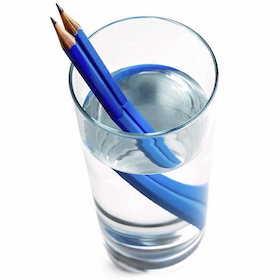RIDS simplifies the accurate calculation of several properties of Air, Water, Seawater, and Sugars of various composition. A typical use of RIDS is to calculate the solids level of a corn syrup from the refractive index. That function of the app is based on an Excel spreadsheet first developed by the author in the early 1980’s when he was employed at the Corn Products’ Moffett Technical Center.
Today’s modern RIDS app expands to include Air, Water and Seawater and employs more detailed formulations that cover a wider range of conditions while maintaining state-of-the-art accuracy over that range.
Air
The refractive index of air is calculated using the Ciddor equation as formulated by Polyanskiy. Thermodynamic and psychrometric properties of moist air are calculated per ASHRAE 2001 except for the vapor pressure of water, which is calculated using the IAWPS-95 formulation and the reformulated enhancement factor of Hardy.
Water
Water properties are from the IF97 formulation of the IAWPS. Available properties include density, refractive index, enthalpy of the as-is liquid, saturated liquid, saturated vapor and the latent heat of vaporization. Special thanks to Ralph Hummeling of Hummeling Engineering for helping us implement his IF97 java formulation within RIDS.
Vapor pressure is calculated using the full IAWPS-95 formulation for maximum range. No enhancement factor is applied, so the reported value is for pure water vapor and not a mix of water vapor in air.
The app gives you the steam tables on your iPhone! If you would like additional properties (eg. viscosity, speed of sound, many others), head over to the RIDS user forum and submit a feature request. Anything available in IF97 could be made available in RIDS
Seawater
Seawater properties come from TEOS-10. At zero salinity, values correspond to those for pure water. Refractive index of seawater is calculated using the Seaver-Millard formulation.
Syrups
The refractive index of corn syrups, sucrose solutions, and blends of both, are calculated according to Wartman et al, as used by the CRA. Density is calculated by the formulation of Maxwell, Kurtz and Strelka (colleagues of the author) including corrections per personal communication.
Today’s modern RIDS app expands to include Air, Water and Seawater and employs more detailed formulations that cover a wider range of conditions while maintaining state-of-the-art accuracy over that range.
Air
The refractive index of air is calculated using the Ciddor equation as formulated by Polyanskiy. Thermodynamic and psychrometric properties of moist air are calculated per ASHRAE 2001 except for the vapor pressure of water, which is calculated using the IAWPS-95 formulation and the reformulated enhancement factor of Hardy.
Water
Water properties are from the IF97 formulation of the IAWPS. Available properties include density, refractive index, enthalpy of the as-is liquid, saturated liquid, saturated vapor and the latent heat of vaporization. Special thanks to Ralph Hummeling of Hummeling Engineering for helping us implement his IF97 java formulation within RIDS.
Vapor pressure is calculated using the full IAWPS-95 formulation for maximum range. No enhancement factor is applied, so the reported value is for pure water vapor and not a mix of water vapor in air.
The app gives you the steam tables on your iPhone! If you would like additional properties (eg. viscosity, speed of sound, many others), head over to the RIDS user forum and submit a feature request. Anything available in IF97 could be made available in RIDS
Seawater
Seawater properties come from TEOS-10. At zero salinity, values correspond to those for pure water. Refractive index of seawater is calculated using the Seaver-Millard formulation.
Syrups
The refractive index of corn syrups, sucrose solutions, and blends of both, are calculated according to Wartman et al, as used by the CRA. Density is calculated by the formulation of Maxwell, Kurtz and Strelka (colleagues of the author) including corrections per personal communication.
